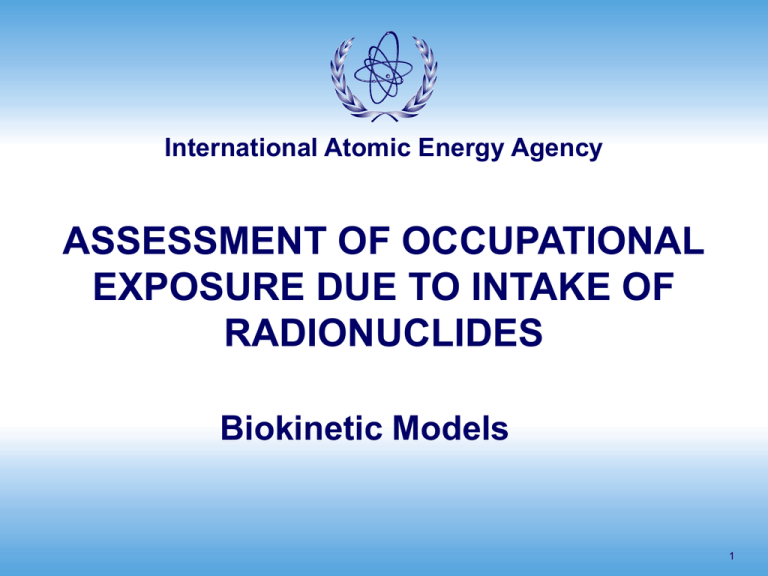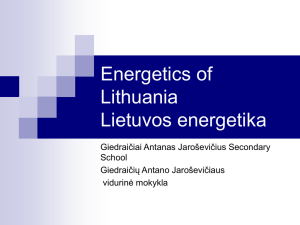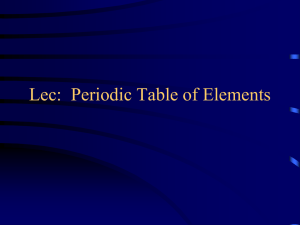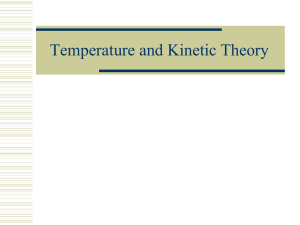
International Atomic Energy Agency
ASSESSMENT OF OCCUPATIONAL
EXPOSURE DUE TO INTAKE OF
RADIONUCLIDES
Biokinetic Models
1
Ingestion
2
International Atomic Energy Agency
Gastrointestinal tract model ICRP 30
Ingestion
Compartment Residence Transfer
constant
time
(d-1)
(h)
24
1
Stomach
Small
6
4
Intestine
(SI)
Upper Large
1.85
13
Intestine
(ULI)
Lower Large
1
24
Intestine
(LLI)
Transfer constant,
= 1/residence time
3
All tabulated values for ingestion
are based on this model
Stomach (ST)
ST
Small
intestine (SI)
SI
Upper large
intestine (ULI)
ULI
B
Body fluids
f1
f1SI
B
1 f1
Lower large
intestine (LLI)
LLI
Faecal Excretion
International Atomic Energy Agency
New Human Alimentary Tract (HAT)
model - ICRP 100
ICRP 60 introduced specific risk estimates and
wT for radiation-induced cancer of the
oesophagus, stomach and colon
Dose estimates needed for each region
ICRP 30 model:
Did not include the oral cavity or the
oesophagus
Treated the colon as two regions - upper and
lower large intestine.
4
International Atomic Energy Agency
New HAT model ICRP 100 /2
Considerable data is now available on material
transit times through the different regions of
the gut using non-invasive techniques
Information has become available on the
location of the sensitive cells and retention of
radionuclides in different regions
New data includes
Differences between solid and liquid phases
Age and sex related differences
Effect of disease conditions
5
International Atomic Energy Agency
New HAT model ICRP 100 /3
6
Data are being used:
to determine default transit rates for the
defined regions of the alimentary tract
for the 6 age groups given in ICRP 56
New information:
For morphometrical and physiological
parameters,
On the location of sensitive cells and in
different regions of the alimentary tract
International Atomic Energy Agency
Anatomy and physiology of HAT
7
Primary functions
To move the food
Digestive function
Absorptive function
Excretion function via liver and biliary tract.
Additional functions
Defensive functions to protect the body from
colonization by bacteria
Contains microbial population that produces
vitamins
International Atomic Energy Agency
Anatomy and physiology of HAT
Overall structure
Detailed structure of different
epitelia
8
Oral cavity, pharynx,
oesophagus
Stomach, small and large
intestines
Villi and crypts structure in
small intestine
International Atomic Energy Agency
Structure of the HAT Model – ICRP 100
9
Deposition and
retention on teeth.
Entry per ingestion,
from Respiratory Tract
Deposition in oral
mucosa or wall of the
Stomach and intestine
Transfer back from the
oral mucosa or walls of
ST and intestine back in
the lumen
Transfer from various
secretory organs or
blood into the contents
of certain segments of
HAT.
International Atomic Energy Agency
Main differences with previous model /1
Oral cavity not present in the ICRP30 model
In ICRP30 model the division of large intestine is in
only 2 regions : ULI and LLI. (in HATM there are 3
regions for the colonic transit)
The ICRP30 model takes into account only decays of
the radionuclide occurring during transit. In HATM it
has been taken into account also transformations of
the radionuclide due to retention in tissues.
10
International Atomic Energy Agency
Main differences with previous model /2
In ICRP30 model absorption of a radionuclide is
supposed to occur only in Small intestine. HATM
includes pathways to account for absorption from :
Oral mucosa
Stomach,
Specific segment of colon
HATM provides age- and gender-specific transit times
for all segments of the tract and for the upper
segments (oral cavity, oesophagus and stomach) it
provides also material specific transit times.
11
International Atomic Energy Agency
Transit times
12
Extremely large deviation from the norm can be
found from constipation or diarrhoea, unusual diet
or pharmaceuticals which can affect the actual
transit times.
So the default transit times may not be appropriate
for individual specific applications.
Uncertainties and variability in transit times are
reported in ICRP 100.
Within a first-order kinetics a transit time of T days
corresponds to a transfer coefficients of 1/T per day
(d-1)
The review of data has been done for the transit
times of all segments of HAT.
International Atomic Energy Agency
Transit times and tranfer coefficients
for Adult Males
13
ORGAN
TRANSIT TIMES
TRANSFER
COEFFICIENTS
1/T
(d-1)
Mouth
Total diet
12 s
Total diet
7200
Oesophagus
Total diet
Fast
Slow
90%
10%
7s
40 s
Total diet
Fast
Slow
90%
10%
12343 2160
Stomach
Total diet
70 min
Total diet
20.57
Small Intestine
4h
6
Right Colon
12 h
2
Left Colon
12 h
2
Recto sigmoid
12 h
2
International Atomic Energy Agency
Absorption from content of HAT
Even if the absorption predominantly took place in the
small intestine, provision is made for the inclusions of
components of absorption from
oral cavity,
stomach or
any segment of the colon.
Absorption from any other segment of the alimentary
tract is depicted as transfer from the contents to the
wall of that segment, followed by transfer to blood in
the portal vein to entry into the general circulation.
14
International Atomic Energy Agency
Absorption from content of HAT / 2
In the planned ICRP reports that will recommend the
use of the HATM for a range of elements, information
for each element will be given in terms of fractional
absorption, replacing the f1 values of Publication 30
(ICRP, 1979) with fA values.
Thus, fA denotes total absorption to blood in the HATM
and represents the fraction of the material entering the
alimentary tract.
It is given by the sum of the fractions of the material
entering the alimentary tract, fi, absorbed in all of the
regions of the alimentary tract:
fA f i
i
15
International Atomic Energy Agency
Absorption from content of HAT / 3
In the majority of cases, information will only be
available on the total absorption of the element and its
radioisotopes to blood with no information on regional
absorption. As in the Publication 30 model the standard
assumption will be that this absorption takes place
entirely from the small intestine so fSI=fA.
On the contrary if an element is known to be absorbed
from the stomach as well as from the small intestine,
values of fST and fSI would be specified, where:
f A f ST f SI
16
International Atomic Energy Agency
Absorption from content of HAT / 4
For the implementation of the HATM in the absence of
absorption from retention in the walls, teeth and oral
mucosa, the following transfer coefficient i,B applies
for the uptake to blood from compartment i of the
HATM.
i , B
f i i ,i 1
i
1 fk
1
Where fi is the fraction of then intake assumed to be
absorbed from compartment i and i,i+1 is the transfer
compartment to the next compartment i+1.
17
International Atomic Energy Agency
Absorption from content of HAT / 5
In the most common case with the absorption only
from the small intestine to the blood the transfer
coefficient is given by SI,B is given by
SI , B
f SI SI , RC
1 f SI
Where SI,RC is the coefficient for transfer from the
small intestine to the right colon (6 d-1).
18
International Atomic Energy Agency
Absorption from content of HAT / 6
In the case of an absorption also from the stomach fST, the transfer
coefficient for uptake from the stomach is given by ST,B is given by
ST , B
f ST ST , SI
1 f ST
Where ST,SI is the coefficient for transfer from the stomach to the small
intestine (20.57 d-1 for adults and total diet). In this case, the transfer
coefficient for uptake from the small intestine ( SI,B ) is given by:
SI , B
19
f SI SI , RC
1 f SI f ST
International Atomic Energy Agency
Dosimetry of HAT
Geometric model for the calculation of SEE values for
the tubulus part of the HATM
20
International Atomic Energy Agency
Dosimetry of HAT / 2
Geometric model for the calculation of SEE values for
the epitelial lining of the small intestine
SEE; Specific Effective Energy
21
International Atomic Energy Agency
Dosimetry of HAT / 3
Depth of target cells in the different sub-regions of the
HATM, in adult male.
The target cells are always the epithelial stem cells.
For some alpha and beta emitters this change in respect to ICRP30 model
and substantially reduced dose estimates as the alpha or beta emissions
originating in the content of the HAT do not penetrate the depth at which
the sensitive cells are thought to reside.
22
International Atomic Energy Agency
Dosimetry of HAT / 4
Comparison in SAF values (g-1) from ICRP 30 and HATM
for the lumen of stomach in adult male. (in function of
electron energy ).
23
International Atomic Energy Agency
Dosimetry of HAT / 5
Comparison of committed equivalent doses and E(50)
for Ru-106 and Pu-239 after ingestion, using HATM and
ICRP 30 models.
24
International Atomic Energy Agency
Dosimetry of HAT / 6
For the dose to the organ “colon” the mass weighted
mean of the dose coefficients of the 3 sections of the
colon i.e. (this implies that the relative risk of radiation
effects is not significantly different in these 3 regions)
hcolon
mrc hrc mlc hlc mrs hrs
mrc mlc mrs
For the time being no calculation has already been
performed with the HATM as the values of fA have not
been indicated by ICRP for the different elements.
25
International Atomic Energy Agency
Entry through Wounds and
Skin
26
International Atomic Energy Agency
Entry through wounds
Much of the material may be retained at the wound site,
however
Soluble material can be transferred to other parts of
the body via blood
Insoluble material translocated slowly to regional
lymphatic tissue
Gradually dissolves and eventually enters the blood
Some insoluble material can be retained at the wound
site or in lymphatic tissue for life
May need to excise contaminated tissues.
27
International Atomic Energy Agency
Entry through wounds. Soluble materials
Soluble materials may translocate from the
wound site to the blood
Translocation rate depends on solubility
Distribution of the soluble component similar
to material entering blood from lungs or GI,
however,
Some exceptions for radionuclide chemical
forms entering blood directly
28
International Atomic Energy Agency
Wound model History
-
In the past ICRP and NCRP both developed a
respiratory tract model in parallel
-
About 10 years ago they agreed to share tasks to
develop biokinetic models
- ICRP: Human Alimentary Tract Model (ICRP 100)
- NCRP: Wound Model
-
29
Both committees had representation from both
organisations
International Atomic Energy Agency
Announced Biokinetic NCRP Wound Model
<20μm
Insoluble
>20μm
Soluble
:Avid
:Strong
:Moderate
:Weak
30
International Atomic Energy Agency
Retention at the wound site for
soluble materials
:Avid
:Strong
:Moderate
:Weak
31
International Atomic Energy Agency
Characteristics of the Wound Model
-
Input material-specific due to its physical and
chemical state: soluble, colloids, particles (≤ 20
µm), fragments (> 20 µm)
-
Soluble material may become insoluble due to
hydrolysis and vice versa
-
Release from the wound site to blood (soluble
materials) and lymph nodes (particles)
-
4 retention classes for soluble material: weak,
moderate, strong and avid due to retention after 1,
16, and 64 d.
32
International Atomic Energy Agency
Values of parameters in NCRP wound model
33
International Atomic Energy Agency
Status of NCRP wound model
-
A set of final transfer rates is given for all 7 default
categories
-
It will be published soon as NCRP report.
-
No dosimetric parameters for wound sources.
-
ICRP will adopt this model; the revision of ICRP
Publication 30/54/68/78 will contain wound
information.
34
International Atomic Energy Agency
Entry through intact skin
Several materials can penetrate intact skin
Tritium labeled compounds,
Organic carbon compounds and
Compounds of iodine,
A fraction of these activities enter the blood
Specific models need to be developed to
assess doses from such intakes, e.g.
behavior of Organically Bound Tritium (OBT)
after direct absorption is quite different from
that after inhalation or ingestion
35
International Atomic Energy Agency
Entry through intact skin
Both the equivalent dose to the contaminated
area and the effective dose need to be
considered after skin contamination.
ICRP biokinetic models can only be used for
the calculation of the effective dose arising
from the soluble component, once the
systemic uptake has been determined.
36
International Atomic Energy Agency
Systemic Activity
37
International Atomic Energy Agency
Uptake
The fraction of an intake entering the systemic
circulation is referred to as the uptake
ICRP models for radionuclides in systemic
circulation are used to calculate dose
coefficients
Following review of data behavior of
radionuclides in the body, a number of
elemental models have been revised
Revised models were also used to calculate
dose coefficients for workers
38
International Atomic Energy Agency
Revision of systemic models
Models for several elements have been revised,
particularly to account for recycling of radionuclides
between compartments (so they are more complicated!)
The model are more physiologically oriented, can be
applied to calculate bioassay quantities, and evaluate
dose to the general population not only to workers.
Previously, a number of radionuclides (e.g. 239Pu) were
assumed to be retained on bone surfaces
- a conservative assumption
Evidence indicates a fraction of plutonium is buried as
a result of bone growth and turnover
39
International Atomic Energy Agency
Revision of systemic models/2
Another fraction is desorbed and re-enters the
blood
Some may be re-deposited in the skeleton and
liver or be excreted
40
In contrast, ‘bone volume seeking’ nuclides,
such as 90Sr and 226Ra, have been assumed to
instantaneously distribute in bone volume
International Atomic Energy Agency
Revision of systemic models/3
The process is actually progressive
Generic models for plutonium, other actinides,
and for the alkaline earth metals have been
developed to:
Allow for the known radionuclide behavior
Account for knowledge of bone physiology
The model for alkaline earth metals has also
been applied, with some modifications, to lead
and to uranium.
41
International Atomic Energy Agency
Iodine
•
Description (from ICRP 67)
•
•
•
•
•
42
Of iodine that reaches the blood :
•
•
a fraction equal to 30% is accumulated into the thyroid gland,
a fraction of 70% is excreted directly in urine.
The biological half life in blood is taken as 0.25 d.
Iodide incorporated into thyroid hormones leaves the
gland with an half time of 80 d and enters other tissues
where it is retained with a half-time of 12 d.
Most iodide (80%) is subsequently released and is
available in the circulation for uptake in the gland and
urinary excretion.
The remainder (20%) is excreted in faeces in organic form.
International Atomic Energy Agency
Iodine
• Model : recycling model
ULI
LLI
43
International Atomic Energy Agency
Iodine
• Age-dependent parameters
10%
44
20%
International Atomic Energy Agency
Caesium
•
Description (from ICRP 67)
•
•
•
•
•
•
45
Systemic caesium is taken to be distributed uniformly
throughout all body tissues
10% of activity is assumed to be retained with a
biological half life of 2 days (A)
90% of activity is assumed to be retained with a
biological half life of 110 days (B)
For female the half time of compartment B is significantly
less than for males.
In some countries there is also evidence of mean
biological half time for adult males shorter than 110 d.
Urinary to faecal excretion ratio of 4:1 is recommended.
International Atomic Energy Agency
Caesium
• Model : Nonrecycling model
80 %
Compartment
A
T1/ 2b = 2 d
20 %
10 %
Urinary
bladder
ULI
Transfer
compartment
90 %
H, P, Cr, Mn, Co, Zn, Rb,
Zr, Ru, Ag, Sb, Ce, Hg, Cf
are as well
80 %
Compartment
B
20 %
T1/ 2b = 110 d
T 1/2b= ln(2)/12 [d]
LLI
Urine
Faeces
46
International Atomic Energy Agency
Caesium
• Age-dependent parameters :
47
International Atomic Energy Agency
Skeleton
for the bone seekers
• Bone formation is made by bone-forming
•
•
48
cells (osteoblasts). They synthesise the
organic matrix and perform mineralisation.
This results in a hard, durable structure (not
permanent).
Throughout life there is a continual
modification (remodelling) of bone by boneresorbing cells (osteoclasts).
Two types of bone structures :
• CORTICAL BONE (Compact)
• TRABECULAR BONE (Spongy, Cancellous)
International Atomic Energy Agency
Skeleton
•
Cortical Bone
•
•
•
•
Hard, dense bone
Forms the outer walls of bones
The bulk of compact bone is found in shafts of long
bones (e.g. femur)
Trabecular Bone
•
•
•
49
Soft, spongy bone
Forms the interior parts of flat bones and of end long
bones
It has much higher porosity than compact bone and
soft tissue content (bone marrow).
International Atomic Energy Agency
Skeleton
Trabecular Bone
Cortical Bone
femur
50
International Atomic Energy Agency
Skeleton
• Figure of bones
•
51
in humans
(ICRP 70)
Skull is about
14-15% (around
1/7) of the mass
of all bones.
International Atomic Energy Agency
Skeleton
Percentages of cortical and trabecular tissues in
bones (ICRP 70)
52
International Atomic Energy Agency
Model for Sr, Ra and U
53
International Atomic Energy Agency
Model for Sr, Ra and U/2
Skeletal activity first deposits on bone surfaces
Return to plasma or migrates to exchangeable
bone volume within a few days
Some activity leaves exchangeable bone
volume is assumed to return to bone surfaces
Remainder is assigned to non-exchangeable
bone volume
Gradually moves to plasma by bone resorption
54
International Atomic Energy Agency
Model for Sr, Ra and U/3
Soft tissue is represented by 3 compartments,
ST0, ST1, and ST2
For radium and uranium, the liver is kinetically
distinct from other soft tissues
Excretion of U through the kidney and
exchange of activity between plasma and
kidney tissues is also considered
55
International Atomic Energy Agency
Model for Th, Np, Pu, Am and Cm
56
International Atomic Energy Agency
Model for Th, Np, Pu, Am and Cm/2
Th and Pu retention and
excretion data are most
easily reproduced using
a 2 compartment model
Liver 2
Liver 1
Blood
GI tract
contents
Liver 2 represents
retention with t½ > 1 year
Faeces
Liver 1 loses a portion of its activity to the
GI tract over a relatively short period (1 year)
Liver 2 shows greater retention of Pu
57
International Atomic Energy Agency
Model for Th, Np, Pu, Am and Cm/3
Am and Cm Liver can
be treated as a uniformly
mixed pool, losing activity
to blood and the GI tract
with a Tb of 1 year
Liver 1
Blood
GI tract
contents
Radioactive material enters Liver 1
Faeces
Part of the material is removed to the GI tract
via biliary secretion
The rest goes to blood.
58
International Atomic Energy Agency
Model for Th, Np, Pu, Am and Cm/4
Urine
Uinary
bladder
contents
Other kidney
tissue
Blood
Kidneys
Urinary path
59
Kidneys are assigned two compartments,
One loses activity to urine
Another that returns activity to blood
“Urinary bladder contents” is treated as a
separate pool that receives all material
destined for urinary excretion
International Atomic Energy Agency










